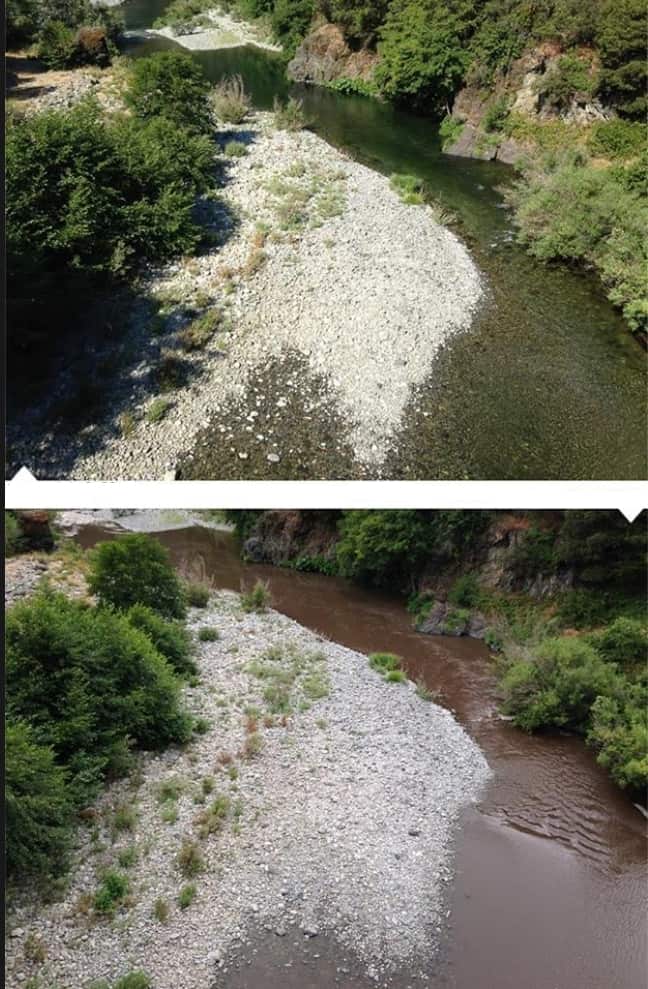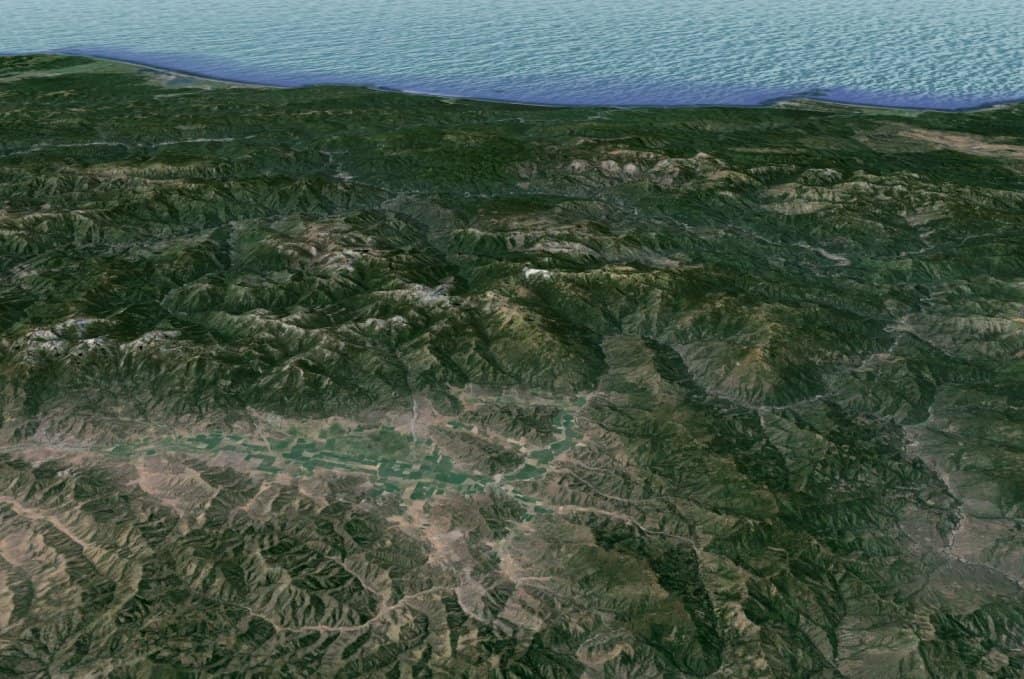I was sent a picture from Oregon the other day that I want to follow up on. An owner has clear-cut some land along the Chetco River. From the picture it looks like they went into the transition area and made the place a moonscape. I know trees grow back but clear-cutting the entire slope to the edge of the gravel bar seems like a really bad idea...
I have not done my research into Shoreline Management in Oregon yet. Do they have regional managers who respond to inquiries regarding waters of the State?
Timber harvesting clear cut, or removal of riparian vegetation on private land?
imaudigger, post: 329437, member: 7286 wrote: Timber harvesting clear cut, or removal of riparian vegetation on private land?
Still waiting for a location to tell if it's private. They harvested everything down to and including the transition zone. The slope is barren and will drain directly into the river. The picture shows a series of slash piles along the edge of the cut. Not real bright..
Could be a fire safe measure. Can you upload the picture so we can see what has your feathers ruffled 😉
The Chetco river is very close to the 2002 Biscuit Complex, which heavily burned 555,000 acres of forest.
NaÌøve efforts to save EVERY isolated resource, has significantly contributed to the complete destruction of the very resources people sought to preserve.
Ironically, the riparian vegetation is the quickest to recover. 2 years later and it is back to being a jungle.
Around here I don't typically see logging occurring right to the water's edge, but slash piles are commonly used as an effective erosion control method.
There isn't a lack of riparian vegetation along the Chetco drainage basin, that's for sure. It's designated as a Wild and Scenic river. Any logging occurring on public or private lands would have to pass public scrutiny.
I am very realistic about appearance versus science. My first job was with a sawmill followed by a lot of development work. That's what made me wonder what these guys were thinking.
The slash piles were left along the treeline at the top of the cut. There is no indication in the photo of any erosion control. I've never seen anything like it up against a river. I will try to get a decent copy of the photo to download.
thebionicman, post: 329432, member: 8136 wrote: I was sent a picture from Oregon the other day that I want to follow up on. ....Do they have regional managers who respond to inquiries regarding waters of the State?
Oregon Department of Agriculture is probably a good place to start.
Tons of stream protection rules here:
http://www.oregon.gov/odf/privateforests/pages/fpaguidance.aspx
Big Brother running amok in Oregon I see. If it's private land, it's private land. Everyone else needs to stay out of the picture.
Holy Cow, post: 329482, member: 50 wrote: Big Brother running amok in Oregon I see. If it's private land, it's private land. Everyone else needs to stay out of the picture.
If it's adjacent to a riparian stream the public has an interest. Fish can't live in a stream that's all muddied up.
Big difference of opinion on that perspective. I better stop or I'll violate some board rules.
Holy Cow, post: 329505, member: 50 wrote: Big difference of opinion on that perspective.
I imagine that the science is going to vary quite a bit depending on the nature of the ecosystem. The kind of stream terrain commonly found in the mountains of Oregon is waaaay different from what you commonly see in Kansas.
Holy Cow, post: 329482, member: 50 wrote: Big Brother running amok in Oregon I see. If it's private land, it's private land. Everyone else needs to stay out of the picture.
So it's ok if I silt in one of the three cleanest rivers in the world? My rights end when they violate yours. It's really that simple.
RE Sediment/silt
This is just based on my experience growing up in an area similar to the Chetco river.
I would go out on a limb here are say that the river is clean because of the geology of the drainage basin.
Sediment is very natural to a stream and thus fish are able to survive in it's presence. If sediment/silt was dangerous to fish, they would not have survived as a species. This is just my common sense talking.
In my back yard, I have what I would consider one of the cleanest rivers. This is despite massive hydraulic mining that occurred at the turn of the century and a 100 years of logging. Every winter the river is brown with sediment, yet come spring it is crystal clean again.
Man cannot come close to generating the volume of silt that naturally enters a stream every year. The picture below is a before/after following a thunderstorm event over a recently heavily burned area. I have full confidence that the fish are surviving and the river will be crystal clear again this spring.
The mountains have been eroding into the rivers since the beginning of time.
When you actually stop and think about it, how could something that occurs naturally since the beginning of time be so detrimental?
The naturally occurring silt in the Chetco is short lived and starts in about 3 months. Having it present between July and mid September wreaks havoc on the breeding cycle. It's a matter of timing. The river certainly will recover. The fish population will experience severe stress.
I am all for using renewable resources. It's just plain silly to destroy things in the process when it's simple not to...
I hear ya. The picture above, was taken about 1 month ago and is 100% naturally occurring.
*Silt happens*
Locally, the problem with silt from lands adjoining the rivers and lakes is what is in the silt today that was not present in the silt of before.
The amount of contaminants in fill dirt for roads and the insecticides and hard metals that are in the adjoining lands has increased. Many of these come from industry overflow into all the areas that are downhill leading to the rivers and lakes.
The number of secret and non disclosed dumping and burial sites for dangerous substances are far more than known by the public. I can think of dozens of places that are locked up and all access have been blocked because of what is buried there. The stuff I've seen floating in creeks and the highlight streaks observed in flowing streams show that they come from various distillate products tied to chemical and wood treating industries.
Every construction job has some place that all the left over supplies are buried and billed as being a part of the final product.
On top of all that, a few local lakes hold 1/2 the amount of water as they held when they were first filled because there is that much sediment within the lake area and more sandbar along the river's course.
In the last 30yrs our lakes and waterways have new classifications between sport lakes that are held at full capacity, water control lakes that go up and down to hold supply to keep other lakes at capacity and lakes that provide water to be treated for municipalities as far as hundreds of miles away. Municipalities buy and sale their water rights and also fight it out in courts to keep their woodland in favor of water sources of these municipalities.
Every year, someone is severely sickened by contaminated water from some part of most every lake around.
Across the counties are numerous stagnate containment ponds at and around closed oil and gas wells that the overflow will go into most every major waterway across NE Texas and surely other parts of the nation that has the same commercial activities.
Bottom line, the erosion events are a natural event that has been goin on for eons, the amount of contaminants changes as time goes on.
I agree with you 100%. THAT is why there are such stringent environmental laws. The majority of the water in the US is disgusting.
All the oil, grease, and antifreeze is washed off the millions of square miles of parking lots, collected in a system of pipes, then dumped directly into the waterways. You don't see people getting too excited about petitioning WalMart to treat their storm water run-off. They are content with parking their car, setting up a card table in front of WalMart and collecting petitions to enact laws which affect far away places.
Sorry about taking so long to reply. I have been a proud Oregonian for 61 years. Protecting OUR rivers is one of OUR greatest responsibilities. If I was concerned about transition areas along river and streams I would expend my energy finding out why state and federal forest and land managers allow FOREST FIRES to destroy miles and miles of water frontage. The timber that came out of the clear cut, instead of burning up in a fire, helps pay for everything in Oregon, schools, roads, police, and in SW Oregon most goverment services. Instead of our legislature taking responsibility for these transition areas our reps. place that burden on individuals to protect these areas. WE, taxpayers, should buy the timber and purchase a resource easements for these transition areas. But our state reps. want to spend millions on tax rebates for solar and 100's of millions for a bridge for out-of-staters that won't be built.
Just my rant.






